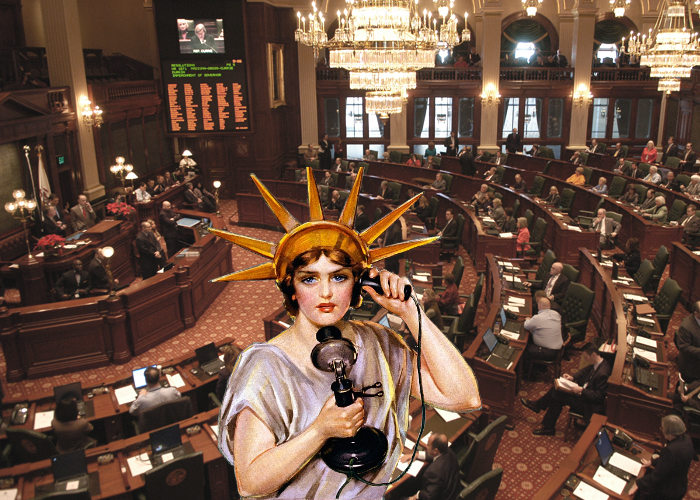Jo Freeman: The Equal Rights Amendment is BAAACK! Much Has Changed Since the First ERA Was Proposed 98 Years Ago

Illustration for ERA on WE Are Woman.us website, Illinois: Would you make a few calls for the ERA too?
By Jo Freeman
The Equal Rights Amendment is back before Congress. This time there is a serious possibility that Congressional action may lead to ratification – which will then go to the federal courts.
First introduced into Congress in 1923, the Equal Rights Amendment was intended to do away with the plethora of state laws which restricted women's property rights, disadvantaged them under state family laws, or barred them from holding office or serving on juries. Proposed by the National Woman’s Party, it was not aimed at those laws enacted to protect women from sweatshop conditions. However, the overwhelming conclusion of legal authorities was that the amendment would nullify or throw open to question all sex- specific laws.
The NWP worked with other women’s organizations to come up with mutually acceptable language but agreement could not be reached. The NWP concluded that protective labor laws limited women's opportunities and should be abolished. In 1943 the language was revised to read "Equality of rights under the law shall not be denied or abridged by the United States or by any State on account of sex."
Women’s organizations battled for fifty years over the importance of equality vs. protection. By 1970 the issue of protective labor laws applying only to women was pretty much moot. Soon labor unions, which had been the staunchest opponents of the ERA, ceased their opposition. On March 22, 1972 the ERA was approved by Congress and sent to the states for ratification. The resolution clause set a deadline of seven years for ratification. Such a clause was first added to the 18th Amendment when it was sent to the states in 1917. It has been part of the resolution clause of most (but not all) proposed amendments since then.
In 1972, few thought the deadline would be a problem. But it was. Conservative women were frightened by the idea of equal rights. The Supreme Court’s 1973 decision limiting a state’s ability to restrict abortion gave birth to a powerful movement against it. This movement saw the ERA as a threat. The kind of constituent pressure that M.C.s had felt at the national level legislators felt at the state level, but for the opposite position. After seven years the ERA was three states short of the necessary 38 for ratification. In 1978 Congress extended the deadline until June 30, 1982. No more states ratified. The ERA appeared to be dead.
A few years ago interest revived. Nevada and Illinois were persuaded to ratify. Whether this is constitutionally permissible or not is an open question. On November 5th Virginia elected a Democratic majority to both houses heightening expectations that it will become the 38th state to ratify the ERA.
In the meantime a resolution to remove the deadline from the original 1972 resolution was introduced into the House by Rep. Jackie Speier (D CA). On November 13, the House Judiciary Committee marked-up the bill. Only a few Republicans attended. They all spoke against it, mostly claiming that the ERA would make it impossible to restrict abortion. "Sex" has replaced "protection" as the primary rationale against equality.
Judiciary Committee Chair Jerrold Nadler (D NY) led off with a powerful statement on why the ERA was still needed. He specifically said that the ERA "includes discrimination based on sexual orientation and gender identity." This is important legislative history if the ERA does become the 28th Amendment. Other Democrats on the Committee also read statements in favor of the ERA, citing history and economics.
After an hour and a half of Members reading statements, H.J. Res. 79 passed by 21-11 in a strict party line vote. Even the lone woman among the Republicans voted no.
Much has changed since the first ERA was proposed 98 years ago. As was true for the 19th Amendment, its supporters were mostly Republicans, including Alice Paul, who spent the rest of her life trying to add an ERA to the U.S. Constitution. In the 1970s the Chairman of the House Judiciary Committee, was Emanuel Celler of Brooklyn, NY, who was determined to keep the ERA from ever being voted on by the full House. Now the Committee Chair is Jerry Nadler, whose district is partially in Brooklyn, and is just as determined to add the ERA to the US Constitution.
© 2019 Jo Freeman for SeniorWomen.com
More Articles
- Jo Freeman Writes: Kennedy vs. Trump at the Libertarian National Convention
- National Archives Records Lay Foundation for Killers of the Flower Moon: The Osage Murders and the Birth of the FBI
- Nichola D. Gutgold - The Most Private Roosevelt Makes a Significant Public Contribution: Ethel Carow Roosevelt Derby
- Jo Freeman Reviews: The Women of NOW: How Feminists Built an Organization That Transformed America
- Oppenheimer: July 28 UC Berkeley Panel Discussion Focuses On The Man Behind The Movie
- Selective Exposure and Partisan Echo Chambers in Television News Consumption: Innovative Use of Data Yields Unprecedented Insights
- Jo Freeman Reviews Thank You For Your Servitude: Donald Trump's Washington and the Price of Submission
- "Henry Ford Innovation Nation", a Favorite Television Show
- Julia Sneden Wrote: Going Forth On the Fourth After Strict Blackout Conditions and Requisitioned Gunpowder Had Been the Law
- Jo Freeman Reviews: Gendered Citizenship: The Original Conflict Over the Equal Rights Amendment, 1920 – 1963






